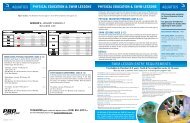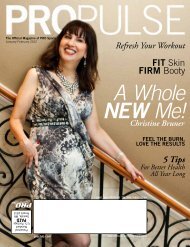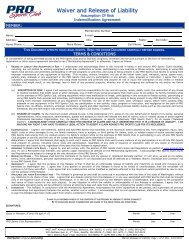spa medicaBy Paula Provenzano, Phytomer National EducatorUnderstanding and RejuvenatingAging SkinNo one wears the same outfit for an entire life and yet, at birth, we are issued one “suit” that will encase theframework of our anatomy for a lifetime. The average woman’s body is covered by approximately eight pounds,or seventeen square feet, of skin. As the only organ directly exposed to both the external environment (UV rays,pollution, etc.) as well as internal physiological conditions (alcohol consumption, dehydration, poor nutrition, etc.),the skin becomes a chronicle of our genetic heritage, dietary habits, sun exposures, and product choices.It is a shame, in many ways, that so much attention is given to erasing the record that time gently, or sometimesnot so gently, engraves upon our faces. However, with all of the research that has been done within the last thirtyyears, we now know that there are alternatives for avoidable aging that can be offset by what we do, or don’t do,to take care of our skin.Scientists have discovered that the skin undergoes two fundamental types of aging: chronological aging, sometimesreferred to as intrinsic aging, and photoaging, or extrinsic aging. The first type of aging reflects the long-held beliefthat our genetic code provides a formula for the systematic or pre-programmed breakdown of the structures thatconstitute our skin. The second type of aging is directly linked to external factors, most notably, the exposureto ultraviolet rays and the myriad physiological alterations that are unleashed as a result of that exposure. TheAmerican Academy of Dermatology once estimated that 80% of the damage previously attributed to chronologicalaging is actually photoaging, while more recent estimates put the percentage even higher.If you would like to see how your skin would look had it not been assaulted by years of constant sun exposure,you might take a look at a part of your body that has been spared from that type of aggression. Upon examination,you will likely see tissue that has minimal, if any, roughness or dryness, and no hyperpigmentation or otherirregularities. By comparing this skin to your facial complexion, you can begin to appreciate what an enormous rolethe sun plays in the aging process.18 <strong>PRO</strong> PULSE SEPTEMBER-OCTOBER 2006
STRUCTURES OF THE SKINThe skin is broken into three layers – the epidermis, dermis and hypodermis. Each layer responds to the aging process differently, which helps tounderstand which solutions work best for the desired repair and rejuvenation. Below is a breakdown of how aging occurs in each of these layers.The EpidermisBarring years of repeated, unprotected sun exposure, which can thicken the skin, theepidermis will grow thinner over time. This is most apparent in Caucasian skin that canbecome nearly transparent in elderly individuals. A thinner skin lacks the depth thatgives it the translucent quality seen in young skin and is more vulnerable to nearly everytype of external aggressor, including: airborne pollutants, waterborne chemicals, UVrays, topical irritants, wind, dryness and extreme temperatures.Fewer layers also means a reduced capacity for moisture retention which results insurface dehydration that manifests in the form of dull skin, fine lines and wrinkles.The DermisThe eyes of all cosmetic researchers have been fixed on the normally unseen, dermallayer of the skin. The collagen and elastin which comprise the matrix, or network, of thedermis are functional components of the dermis for many years. As this matrix weakens,it allows for the formation of deeper wrinkles and the loss of tonicity.The HypodermisOne of the more significant shifts that takes place in the aging process is the reconfiguration of fat cells. In some individuals, when they gain weight theyincrease the amount of tissue, which begins to droop and sag when it lacks the tonicity of youth. This is usually seen around and under the jawline,and contributes to the appearance of “jowls,” and/or a “double chin.” A more common scenario is the loss of fat, which diminishes the plumpness inappearance typically associated with youth and results in hollow cheeks.REPAIR AND PREVENTIONWe can’t stop the aging process, but we can repair and lessen furtherdamage through products, cosmetic dermatology and lifestyle changes.These small steps can help you look great today, tomorrow, and for yearsto come.ProductsOver the past several years, scientists and chemist have spent countlesshours in search of active ingredients that will repair the structures affectedby aging. Two of the biggest players in the world of ingredients have beenAlpha Hydroxy Acids and Retinoic Acid or Retinol. Alpha Hydroxyl Acids,or AHA’s, speed up the removal of dead skin and decrease the appearanceof hyper-pigmentation and fine lines. Retinoic compounds, which wereoriginally used in the treatment of acne, have been shown to improvethe surface texture of skin, reduce irregular pigmentation, wrinkles andcan increase dermal collagen if applied daily for several months. Startingat lower level retinols and slowly increasing the strength as your skinacclimates, lessens the irritation that some experience.Spa Medica offers another solution through dermatological grade productlines, SkinMedica and SkinCeuticals. The TNS Recovery Complex bySkinMedica contains a proprietary blend of multiple human growth factors,soluble collagen, matrix proteins and antioxidants. SkinCeuticals CE Ferulicserum boasts a 95% increased in efficacy to sunscreens, is a powerfulantioxidant, stimulates the growth of collagen and inhibits melanocyte cellsfrom over producing pigmentation caused by the sun, lessening signs ofsun damage and preventing further damage to the skin. In conjunction,they add a powerful component to any anti-aging skin care regime both inthe prevention and treatment of environmental damage to all skin types.The correct skin care products in conjunction with cosmetic services cantake years off anyone’s appearance, as well as making your cosmeticprocedure results last much longer.ServicesSpa Medica offers the latest technology and services to repair and rejuvenatethe skin. The following anti-aging treatments are available in Spa Medicaby calling (425) 861-6281.Injectables: Botox is well known for its amazing wrinkle-reducing ability, andover time can prevent wrinkles before they’re etched into your face by stoppingrepeated muscle contractions that contribute to lines. Restylane and Radiessehelp to plump the skin, which restores fullness and volume to the face andlips. Both products can provide long-lasting results Restylane 6-12 months, andRadiesse up to 2 years.Photorejuvenation: Using deep pulses of light, this non-invasive therapyrevitalizes skin’s look and feel by effectively treating areas of sun damage, brokencapillaries, redness from rosacea, brown spots and more, while stimulatingcollagen to lessen fine lines on the face, neck, chest and arms.Titan: Designed to firm up targeted areas of the body, Titan is a safe, painless,and non-surgical treatment that can reduce the signs of aging by stimulatingcollagen and restoring firmness to the skin on the face, arms, abdomen, andmore.Lifestyle: Many aspects of our lifestyle – namely what we eat, drink and exposeourselves to, can either slow down or speed up the development of everythingfrom wrinkles and crow’s feet to cancer and heart disease. The primary cause ofaging skin is exposure to UV rays, so start avoiding the sun, and you will preventfurther damage. In addition, stress increases the so-called age-acceleratinghormone cortisol. Drinking alcohol, smoking and eating sugary and fried foods,which we often turn to when we’re stressed, cause cortisol and insulin levelsto rise, which have an impact on the aging of the skin. Exercise is a powerfulweapon in fighting aging. It is the cheapest and most effective way to regulateyour hormones, reduce stress, maintain tone and muscle mass, resulting in amore youthful overall appearance.<strong>PRO</strong>CLUB.COM 19
















